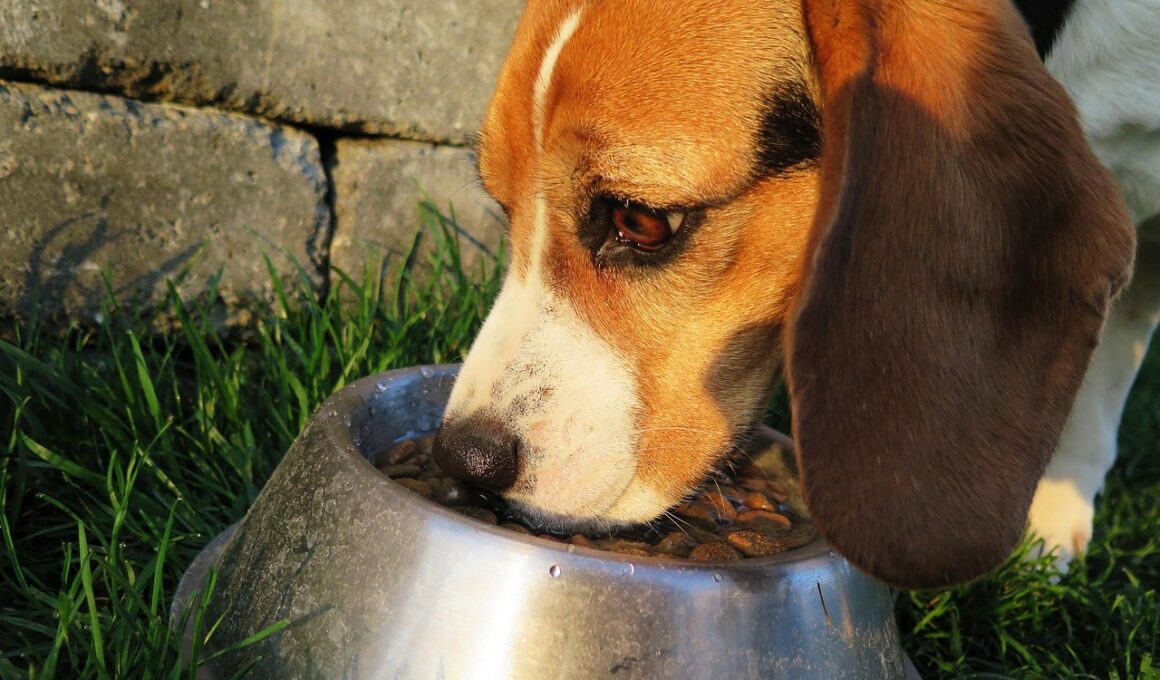Feeding Small vs. Large Breeds on the Go: What You Should Consider
When traveling with your dog, understanding their nutritional needs is crucial. Both small and large breeds require distinct feeding strategies. First, consider the size of the portions. Small breeds often benefit from several smaller meals throughout the day, while larger breeds may thrive on fewer, larger meals. When on the go, this can dictate how you prepare and pack their food. For small dogs, lightweight travel bowls and easy-to-store kibble are essential. For larger breeds, keep in mind the calorie density of their food, as larger meals may be more challenging to prepare during travel. Additionally, consider the type of food you’re bringing. Look for travel-friendly options that are easy to digest and appealing to your dog. Ultra-dry kibble or pre-packaged wet food can be convenient. Be sure to include water as well, and always carry their favorite healthy treats. Traveling can disrupt routines, so bringing a container or bag for storing food while you travel is beneficial to maintain organization. Also, remember to bring along your dog’s travel identification, including any necessary dietary requirements.
Nutritional Requirements for Small Breeds
Small breeds have unique nutritional requirements that must be addressed even during trips. Their high metabolism means they need to eat more frequently and require nutrient-dense meals. A primary consideration when traveling is timing. Since small dogs need to eat multiple times a day, schedule meal times around your travel itinerary. Packing portions that cater to each meal will help maintain their energy levels. Consider using plastic containers that stack easily in your bag, minimizing travel chaos. Additionally, small breed owners should keep an eye on the size of the kibble; it should be easy for them to chew. There are excellent brands that offer tiny, nutrient-rich kibble designed for their size. Furthermore, include some wet food as it is often more palatable and hydrating for your pet. Treats are also essential for rewarding good behavior on your travels. Opt for healthy, low-calorie options to avoid overfeeding. Essentially, your approach to feeding during travel should be flexible but structured, ensuring that your small companion remains healthy and happy while on the road.
Feeding large breeds presents its unique challenges, especially when traveling. Due to their size, they are at higher risk for specific health issues, like bloat, especially if they are fed inadequate meals. Ensure that their food is proportioned correctly to prevent overeating at once. Dehydration can also be a concern when on the go, so plan to offer water regularly. When packing food for large breeds, consider how you will transport large volumes; individual serving containers can be very useful here. Their meals can also be heavier, so a stable and balanced kibble that meets their nutritional needs and is easy to digest is vital. Additionally, creating space for larger food storage bags can help in organizing their supplies. If your large dog has specific dietary needs, it’s essential to research travel meals or dehydrated food that can accommodate them. Boredom can also impact your dog’s eating habits; consider bringing extra toys or engaging activities. Just like small breeds, treats are essential when maintaining good behavior while traveling. Make sure you have enough healthy options on hand to keep them motivated and content during your journey.
Staying Organized with Food Supplies
Keeping your dog’s food organized is vital during travel. Meal prep can be as crucial as workout plans for your dog. Adopt an easy-to-follow system for meals and ensure you carry all necessary supplies. First, pack foods that prevent spoilage, such as vacuum-sealed bags. These will reduce waste and ensure your dog gets fresh and appetizing meals. When preparing food, investigate portable storage containers. These can store both kibble and canned food efficiently. Next, bring measuring cups to provide the right serving sizes. Even while on the road, maintaining portion control will help to ensure your dog’s health and nutritional requirements are met. Additionally, a travel water bowl can make hydration management smoother. When you’re on the go, it’s easy for pets to overlook necessary hydration. A collapsible water bowl takes minimal space in your pack, allowing you to offer water at any time. Don’t forget to carry a few disposable bags for cleaning up after mealtime—both for hygiene and courtesy to other travelers. A well-organized approach means less stress and more enjoyment for both you and your dog as you travel.
Hydration is critical for dogs of any size, particularly during travel. Depending on the environment and activity level, dogs may become dehydrated quickly. Always ensure you have enough water for both you and your pet while on the road. It’s imperative to choose an appropriate travel water bowl. A portable, spill-proof option will make it easier to provide water during pit stops. Be mindful of the weather too; hot climates can exacerbate hydration needs. Depending on the size of your dog, portioning out their water intake at mealtimes can also help control consumption. For larger breeds, hefty bowls that withstand their enthusiasm may be necessary. For smaller breeds, consider a lightweight option that’s easy to pack. Also, incorporate high-water content snacks such as watermelon or cucumbers if your pup enjoys them. Those snacks can serve as both treats and a source of hydration. Regularly check for any signs of dehydration, such as lethargy or dry gums, and prioritize your dog’s hydration as one of your travel essentials. Your dog’s well-being, on the road, should never be compromised.
Understanding Food Allergies and Sensitivities
Traveling with dogs that have food allergies or sensitivities requires extra caution. Before heading out, consult with your vet about any dietary restrictions. When packing food, label everything clearly; this can help prevent any mix-ups while traveling. Both small and large breeds may have unique reactions to specific ingredients. For your small breed, a single allergic reaction can mean serious health risks; therefore, bringing their regular food is essential. If your large dog has proven sensitivities, consider pre-packaged meals. Make sure these meals are nutritionally balanced as well. Research the brands that offer safe and tasty options compatible with your dog’s requirements. Incorporate a selection of individual snacks that are allergen-free for same-day consumption. Being prepared with safe food for your pet will ease your anxiety during travel. Bring along any required medications or supplements they may need. Your travel checklist should always include your dog’s health needs. In this way, you can avoid tedious searches for alternative foods that may cause adverse reactions and keep your furry friend comfortable and happy.
Lastly, remember that actual travel can also affect your dog’s eating habits. New environments can cause stress, which might lead to loss of appetite. Creating a calming eating space for your dog can encourage them to eat. No matter if small or large, place their food and water bowls in a quiet area away from travel distractions. Also, establish a routine around meal times. Consistency can help your dog feel secure, even in unfamiliar surroundings. If your dog struggles to eat while traveling, consider softening their food with warm water or broth. This can increase its palatability, making meals more desirable. Monitor their eating patterns and be patient if they don’t eat as much at first. Always be alert to signs of discomfort or stress-related behaviors. Should you observe not eating for extended periods, consult a veterinarian promptly. Remember to balance exploration and enjoyment with their nutritional needs. With thoughtful preparation and understanding, traveling with your dog can be a fulfilling and enjoyable experience.
In conclusion, feeding and nutrition play a pivotal role in ensuring both small and large breeds travel well. Preparation is key to maintaining their health and happiness on the go. Keep in mind their individual needs for portion sizes, food types, and hydration. Structuring meals, packing wisely, and understanding potential food sensitivities will ensure a smoother experience for you and your dog. Whether traveling a short or long distance, stick to their routines as closely as possible, facilitate access to their favorite foods and water, and create a supportive environment for them at meal times. Familiarity in routines can go a long way in keeping your furry companion calm and relaxed while exploring new places with you.


